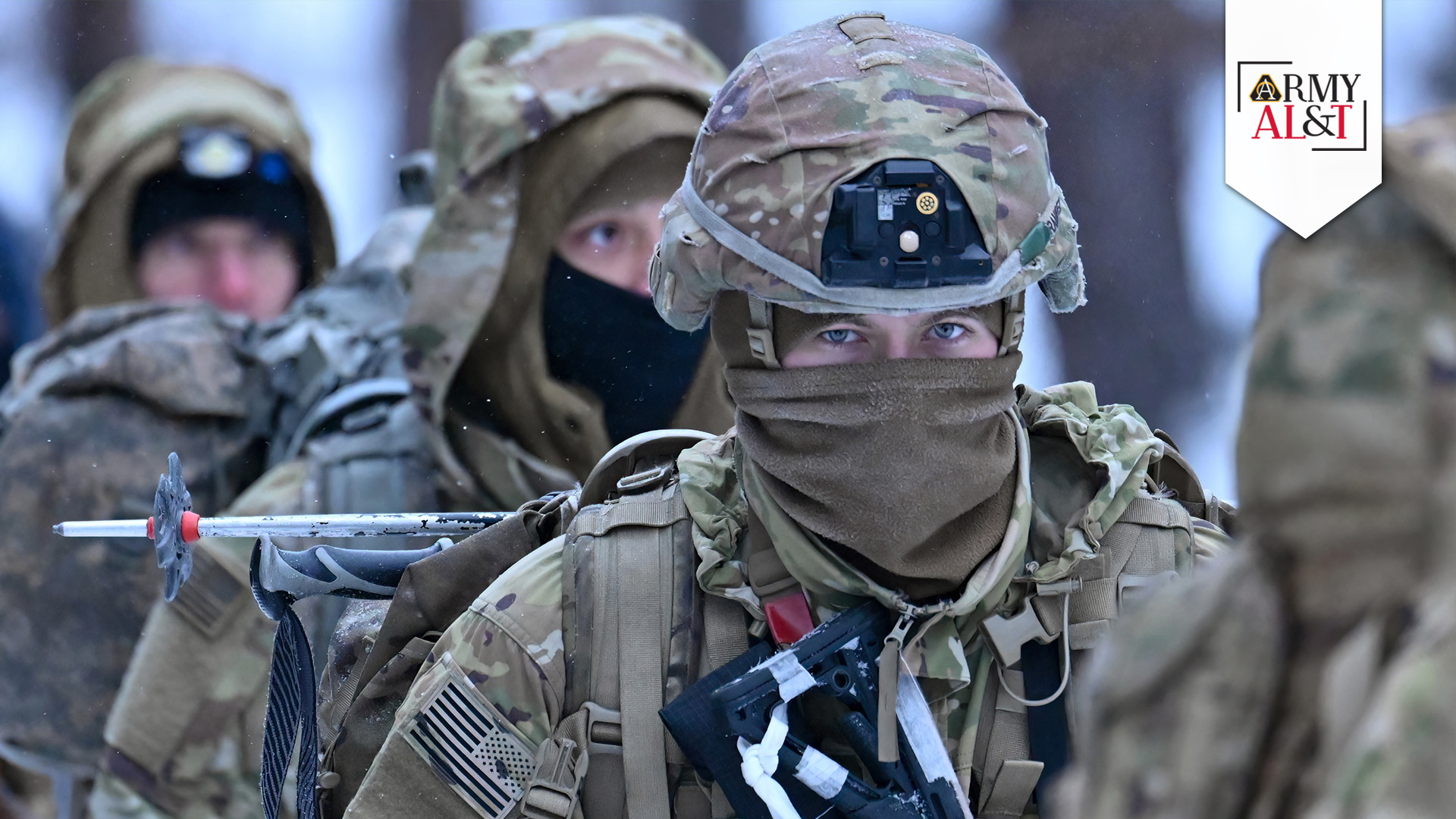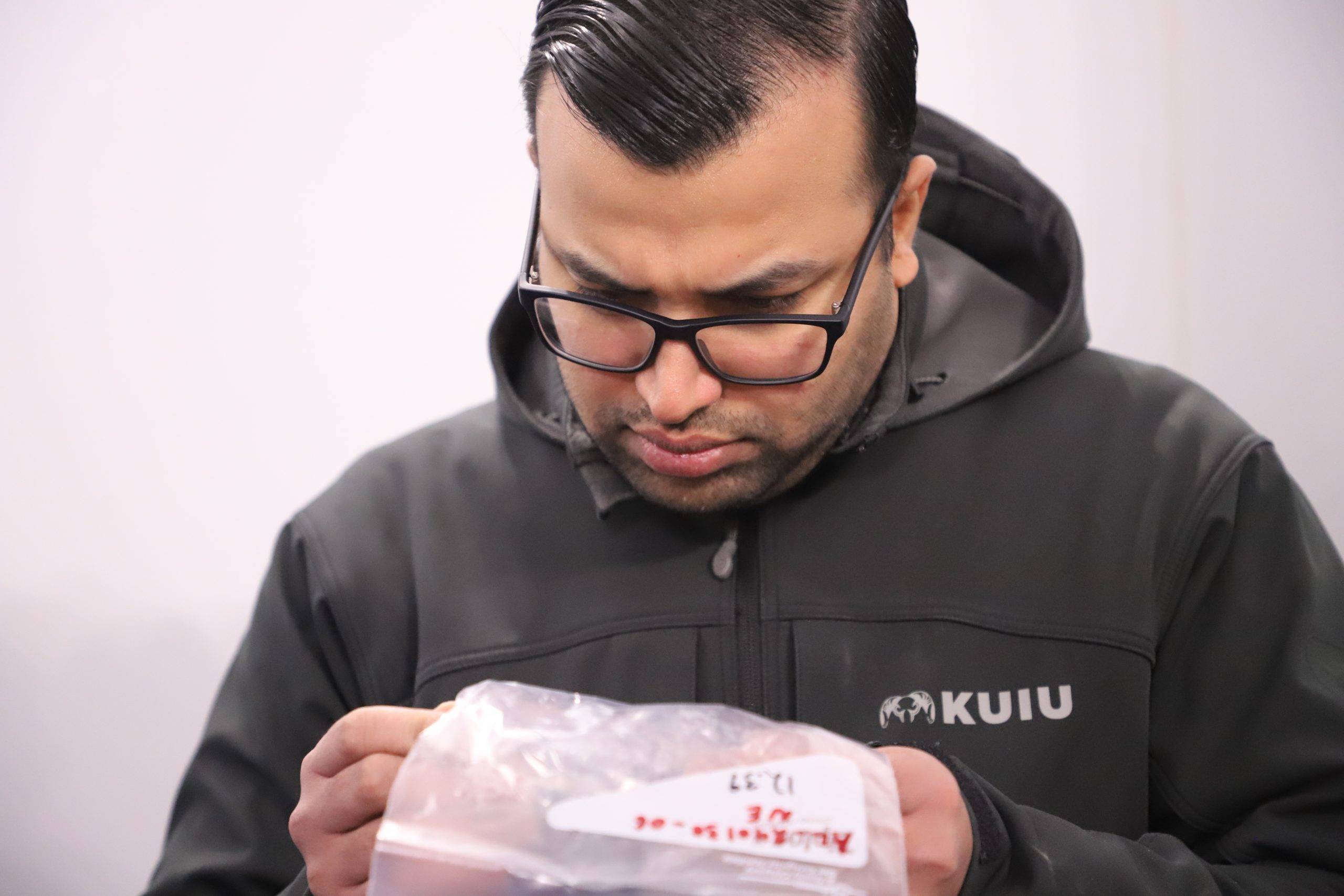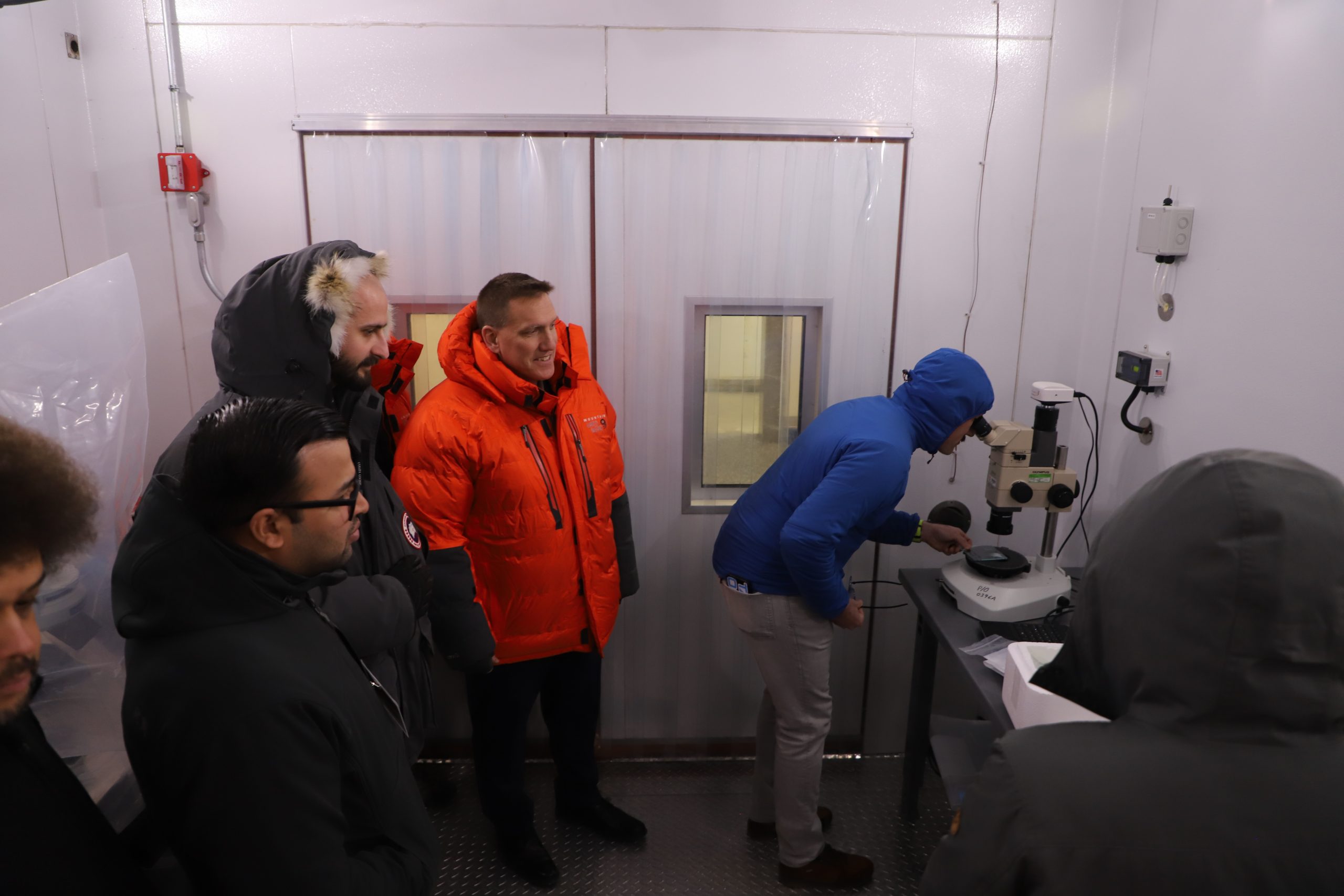
(Photo by John Pennell, 11th Airborne Division)
by Rebecca Wright
When thinking about the Arctic, images of snow, ice—maybe even a polar bear—likely come to mind. Located at the northernmost region on Earth, the Arctic covers eight countries including the U.S., Canada, Denmark, Norway, Finland, Iceland, Sweden and Russia. Approximately 4 million people call the Arctic home along with a vast amount of wildlife, large and small. It also is a region that experiences extreme weather changes, including intense cold, high winds, even days when the sun does not set or days when the sun does not rise.
For the U.S. Joint Force and DOD, the impacts of climate change and an evolving geopolitical environment reach beyond snow and polar bears. Although the Arctic’s weather conditions remain extreme and at times can be dangerous, the Arctic terrain is becoming more accessible due to warming temperatures. With ice melting and opening transportation pathways that were not there before, both peers and adversaries are expanding activities in the area. Improving infrastructure, increasing mapping of the region, strengthening military capabilities and protecting service members from the cold are some of the efforts that the DOD is investing time and research into. It is essential that the DOD maintains readiness in the Arctic in order to safeguard natural resources, shipping routes and North American territory from potential threats, while also being committed to the preservation and protection of both the Arctic’s environment and its people.
ICE CONTROL FOR COLD ENVIRONMENTS
Enhancing the U.S. military’s capabilities and safety in the Arctic is no small feat—specifically when it relates to the extreme cold and icy conditions. Weapons freezing, Soldiers suffering from frostbite and other cold-related injuries, along with negative impacts on electronics and military transportation are some of the obstacles faced. They all pose serious risks.
To assist in these efforts and in support of the 2024 DOD Arctic Strategy, the U.S. Army’s Arctic Strategy (Regaining Arctic Dominance) and additional DOD and Joint Service strategies, the Defense Advanced Research Projects Agency (DARPA) launched the Ice Control for cold Environments (ICE) program which has a mission to “develop solutions for extreme cold weather DOD operational challenges by discovering and optimizing biologically-sourced or inspired molecules to enable tuned inhibition or nucleation of ice crystallization, propagation and adhesion.”
In layman’s terms, the ICE program is exploring biologically-enabled materials for ways to control and manipulate ice to protect military personnel and assets. “The overall goal of the ICE program is to basically use molecules and materials that cold adapted organisms already employ to help them survive and take [those] materials … and then use them in operational environments to help our warfighters operate more effectively in cold Arctic conditions,” said Christopher Bettinger, Ph.D., DARPA program manager in the Biological Technologies Office. “Essentially, we’re learning from nature, right? What is and specifically how does nature control and modulate ice?”
ICE IS A HOT TOPIC
The U.S. Army Engineer Research and Development Center’s (ERDC) Cold Regions Research and Engineering Laboratory (CRREL) plays an important role in the program by serving as the Independent Verification and Validation (IV&V) partner as well as supplying partner institutions with novel microorganisms adapted to cold conditions. The DARPA ICE program launched in January 2024 with a two-day kickoff held at ERDC-CRREL in Hanover, New Hampshire. Emily Asenath-Smith, Ph.D., a research materials engineer at ERDC-CRREL and founder of the Advanced Materials Team, is leading the IV&V effort for the ICE program. Asenath-Smith’s research has focused on ice materials science for 10 years. Materials science is a field that researches and develops materials along with studying material behavior. These studies can lead to the modification and improvement of existing materials or even development of new and enhanced materials.
“We actually make ice in the laboratory and then use various material science strategies to see if we can manipulate the properties,” Asenath-Smith said. “So, can we make ice not melt as fast? Can we make it stronger? Can we make it more or less reflective? These are materials science perspectives—we’re using structure and processing to tune the properties of ice.”

ICY CAPABILITIES: Emily Asenath-Smith, Ph.D., research materials engineer at ERDC-CRREL demonstrates CRREL laboratory capabilities to performer team members of the ICE program in January 2024. ICE is a DARPA program that aims to manipulate ice material properties to safeguard military assets and personnel. (Photo by Justin Campfield, ERDC-CRREL)
Typically, in the field of materials science, there are standards established, usually by the American Society for Testing and Materials or the International Organization for Standardization. For example, if an aircraft needs to be deiced, the deicing material and the process have specific governing standards. Asenath-Smith explains that currently there aren’t any formal standards that govern ice materials or coating technologies to mitigate ice adhesion. “One example is that if we want to use ice to construct a free-standing bridge over an open gap, there’s no standard to go to. We perform experiments like this at CRREL,” she said. “These types of studies ensure that cutting edge technologies are transitioned to U.S. military applications and operations in cold and extreme environments.”
But why try to manipulate and control ice? “Ice is an adversary. Ice sticks. It causes catastrophe. It downs planes. It collapses utilities. Ice creates messes, right?” Asenath-Smith said. Discovering ways to control ice properties can lead to methods that can mitigate some of the troubles that ice can cause. However, ice serves a dual role in our environment. While it can create dangerous conditions and disruptions, it also is a valuable resource. “Ice can be the only readily available material that you have in the Arctic, and we seek to leverage it to fill deficiencies in the material supply line in regions that are extreme and remote like the Arctic.”
While the ERDC-CRREL team is not at the point of developing new materials just yet, the team is researching and testing how some of the already commercially available products can meet specific standards and how they can be applied. Many of us have seen, and maybe even used, a deicing material during a winter storm. But can these deicing products be synthesized to meet standards to be used on military assets? “Some of these products are already commercialized, but they have not been demonstrated on military assets. For example, research on how these materials perform at large scales is needed. Consider the potential cost of coating an aircraft or a ship with a coating that prevents ice adhesion in laboratory studies only to find out that the coating doesn’t mitigate ice in the field scenario or on a large structure,” Asenath-Smith said. “Our research is aimed at transitioning ice and icing technologies to meet these types of needs.”
BENEATH THE ICE
An abundance of research and knowledge is coming from laboratory-created ice by analyzing it, creating different scenarios to learn how it behaves and testing various materials on it to see how it reacts. But what about outside of the laboratory? There is an abundance of natural ice in the environment that has been around for thousands of years.
There is a lot that can be learned from naturally occurring ice especially from a biological standpoint through the practice of biotechnology—the use of living organisms to develop technologies and processes that can be used to create new products. Robyn Barbato, Ph.D., a research microbiologist at ERDC-CRREL, is performing a wide variety of research as part of the Soil Microbiology team. This involves the exploration of a cold region’s microbiome—which is made up of microorganisms that have adapted to live and grow in extremely cold temperatures—and extracting and isolating the microorganisms, including bacteria and fungi, that are living in the permafrost. “Permafrost is ground that’s been frozen for at least two years. And that is thawing, and the microorganisms are waking up. We’re isolating bacteria and fungi [which] means we’re taking them out of the permafrost and we’re looking at them as individuals,” Barbato said. “Ice can be very pesky for equipment for the Air Force, the Army, the Navy. As it gets colder, a thin film of ice can be very problematic in whatever you’re trying to do. Fly a helicopter, use a drone, fly a plane. Deicing is a challenge. They [bacteria] can make proteins that can inhibit ice formation. Those are called antifreeze proteins, and you can inhibit ice as well using these bio-inspired materials.”

LEARNING FROM NATURE: An ICE program performer team member inspects an ice sample during the program kickoff event held at ERDC-CRREL in Hanover, New Hampshire. (Photo by Justin Campfield, ERDC-CRREL)
Microorganisms, plant life and wildlife are thriving in subzero temperatures. However, humans continue to struggle. By studying the antifreeze proteins found in microorganisms, the ICE program teams hope to develop new bio-inspired products that can be used to modulate and control ice. Antifreeze proteins can inhibit or delay the growth of ice, ice nucleation and ice adhesion (how likely ice is to stick to a surface). Asenath-Smith explains that ice nucleation is the process where the smallest particle of ice forms when enough water molecules come together to form a solid, and this solid will continue to grow as long as there continues to be water available. “Imagine fish that live in the Arctic Ocean, and they are swimming around in water that’s below freezing … Why don’t they freeze? While the fish might have tiny ice crystals in their bodies, they have special proteins that ultimately inhibit uncontrolled ice growth. Such antifreeze proteins prevent ice from puncturing cells and breaking veins, to ensure their survival below freezing,” Asenath-Smith said. “This example illustrates the heart of what the DARPA ICE program is pursuing from a biological perspective—to leverage biological adaptations that allow life to survive in cold and extreme environments.”
While developing methods to protect our nation’s assets are of utmost importance, in recent years the Army has been prioritizing reducing its negative impact on the environment. By extracting microorganisms from the local environment and creating new materials for the military, not only does it give the U.S. military a competitive edge, but these materials will have less negative environmental impact. “The idea is that it’s more suited to return to that environment and that the environmental effect would be minimal,” Barbato said. “Biology is so interesting and how the military is looking at biotechnology to solve these problems because these organisms have existed in these situations for thousands of years adapting to survive. So, if we can understand them, then we can help create new materials for the U.S. military to have a competitive edge,” Barbato said.
Barbato explains that once the microorganisms are extracted, they can be provided to one of the ICE program performer teams. The performer teams will then study or genetically modify the microorganism’s properties and provide them to Asenath-Smith’s team who will perform icing studies and the formal IV&V processes at the Ice Adhesion Facility where deicing technologies are tested and evaluated for a wide range of industry and military applications.

INTO THE COLD: Ivan Beckman, Ph.D., acting director of the ERDC-CRREL (orange coat), Christopher Bettinger, Ph.D., DARPA program manager (blue coat) and performer team members of the ICE program inspect ice samples inside an ERDC-CRREL cold box. (Photo by Justin Campfield, ERDC-CRREL)
A FROZEN FRONTLINE
So, what can all this research and development potentially do for Soldiers? From July 2022 through June 2023, 423 service members suffered from at least one cold weather injury with the highest injury rate occurring amongst members of the Army and frostbite being the most common cold weather injury suffered. Therefore, being capable of preventing cold weather injuries, such as frostbite, can have a significant impact on Soldier readiness. “They [DARPA] are not just interested in using biological examples and products to control ice, but also how can we help humans survive more effectively in this cold environment?” Asenath-Smith said. “Imagine you are going to wear a balaclava, which is like a ski mask, and every time you exhale the vapor in your breath freezes on the fabric. Now you’re at risk of getting frostbite on your nose and your lips because your gear is icing up.” She explains that there is one commercialized product that can be used for the treatment of frostbite but there isn’t anything available yet to prevent it. “If you can prevent the freezing of tissues in fish internally, is there some way that we can leverage that to prevent freezing of tissues externally on humans?”
The ability to provide medical treatment, ensure communication devices remain operational and managing ice accumulation on military equipment are a few additional challenges the military is facing in Arctic conditions. Imagine a medical emergency when intravenous (IV) fluids need to be administered, however the IV fluids are frozen solid. Or experiencing a loss of communication because antennas and satellites have frozen and collapsed due to the weight of the ice that has accumulated. The buildup of ice on ships can result in an increase in their center of gravity, causing them to capsize. Military aircraft can also experience increased weight if they accumulate ice. Additional negative impacts to aircraft can include frozen propellers, rotors, and even its landing gear. The ICE program’s research has all these obstacles in mind. The IV&V team will continue to work with the performance teams and through ongoing testing and development efforts, while ERDC-CRREL aims to overcome some of these hurdles.
CONCLUSION
The ICE program’s recent research and development efforts are just the tip of the iceberg. Currently, the program is in Phase 1—also referred to as the discovery phase—and is broken out into two tracks. Bettinger explains that during Phase 1, performance teams are conducting field research, establishing testbed experiments, developing molecules, and collecting and testing samples for ice modulating proteins and making inferences about possible capabilities of certain proteins (such as preventing ice from growing). “The first phase is really broken out in those two efforts we have basically. One track is discovering those molecules that might exist and then the [other] track is building testbeds to evaluate their prospective performance,” Bettinger said. Once Phase 1 is complete by August 2025, Phase 2 will be formulation and application-driven by taking the discovered proteins and researching how they can be engineered into a product. “You think about protecting our warfighters by having those same proteins that the bacteria use, right? But now maybe we develop them and formulate them into an applique or a lotion or a gel or a cream that we can put on our hands,” Bettinger said when discussing the future development of frostbite protection. “That’s already endowed to bacteria but let’s bring them [the proteins] over to the human.”
As the climate continues to warm, developing eco-friendly ways to better protect warfighters in extreme weather conditions in the Arctic not only assists in the safety of our Soldiers, but in our national security objectives as well. The ICE program continues to study and test methods to potentially overcome obstacles such as frostbite, hypothermia and loss of functionality pertaining to military assets in the extreme cold. Instead of viewing ice only as a hindrance, the ICE program’s research and testing on how ice can be used as a tool can better position the Army to protect Soldiers and safeguard our nation’s interest.
For more information, go to https://www.darpa.mil/program/ice-control-for-cold-environments or contact Emily Asenath-Smith at emily.asenath-smith@usace.army.mil or (603) 646-4131.
REBECCA WRIGHT is a writer and editor with Army AL&T and the U.S. Army Acquisition Support Center at Fort Belvoir, Virginia. She has more than 15 years of experience writing and editing for DOD and the U.S. Department of Justice.







